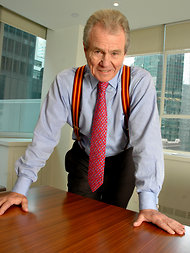 Joe Tabacca for The New York TimesRobert F. Greenhill, head of Greenhill Company. The company has pledged to reduce its compensation-to-revenue ratio.
Joe Tabacca for The New York TimesRobert F. Greenhill, head of Greenhill Company. The company has pledged to reduce its compensation-to-revenue ratio.
Is Wall Street cutting bonuses enough?
That is a question worth considering amid chatter that investment banking bonuses are expected to be the lowest they have been since 2008 amid lackluster profits.
Few people outside the industry are shedding tears. The average Goldman Sachs employee was paid $292,397 in the first nine months of 2011, down about 21 percent from the same period in 2010, when the average payout was $370,056. That is of course, an average, and includes the salaries of those on the lower scales, like support staff.
Each Goldman partner is still expected to take home at least $3 million; in previous years, payouts twice that amount were considered common for the top echelon.
While the total compensation reported by big banks in their 2011 results may be lower, keep an eye on another, and perhaps more important, yardstick that is likely to increase at some firms: the compensation-to-revenue ratio.
DealBook Column
View all posts
At Goldman Sachs, for example, compensation as a percent of firm revenue is expected to rise to 44 percent in 2011, from 39.3 percent in 2010, according to Mike Mayo, a bank analyst with the brokerage firm CLSA. The firm’s revenue is expected to drop about 22 percent and its profit is expected to fall 7.2 percent. Its shares have fallen 45 percent in the last year.
At firms like Morgan Stanley, where share prices tumbled 43 percent in the last year and pretax charges worth $1.8 billion are expected to be booked for the fourth quarter, the compensation-to-revenue ratio is also expected to jump higher. In its 2010 fiscal year, its investment bank paid out 50.7 percent of revenue in compensation.
It is an odd Wall Street paradox: in down years, a higher percentage of a firm’s revenue is paid to employees.
“In the tug of war between employees and shareholders, the employees are winning,” Mr. Mayo said. He pointed out that it was still often employees in the upper ranks, including those in the C.E.O. suites, who took home the largest share of the compensation. “Wall Street has its own 99 percent and 1 percent,” he said. “The 1 percent continues to win against the 99 percent.”
He continued: “Is the incentive pay an incentive, or is it an entitlement?”
For the last several years, while recovering from the financial crisis, the biggest investment banks have tried to reduce the percentage of revenue they have paid employees, bowing to investors and regulators. Until just recently at Goldman Sachs, for example, about half of revenue was used to pay employees.
“You used to be able to set your watch by that 50 percent,” said Glenn Schorr, a banking analyst with Nomura Securities. Now, however, the compensation ratio is expected to rebound somewhat. “It’s a tough balancing act, especially as revenues are down.”
Bank executives have long said that they must pay a larger slice of a shrinking pie in bad times to retain their top people. In a bad environment for the entire industry, it remains unclear exactly where all these people would go.
Firms say that their greatest assets are not factories, equipment or intellectual property but the people who ride their elevators everyday. And in fairness, when revenue jumps at Wall Street firms, compensation has not always kept up.
The compensation-to-revenue ratio may be particularly difficult to calculate in 2011 because of an obscure accounting maneuver called debt valuation adjustment. Under it, firms have posted revenue gains in 2011 based on the deterioration of their credit quality. (The explanation for this is so convoluted that it’s best saved for another column on another day.)
Still, investors will keep their eyes peeled for that number. Nelson Peltz, the activist investor who runs Trian Partners, wrote a scathing letter to State Street’s board late last year, questioning the payout as measured against earnings per share.
He contended that State Street in 2010 “paid more in compensation than in any year other than 2008 but generated the lowest E.P.S. in its recent history. Shareholders have subsidized these increases in employee compensation.”
One firm that has been under the spotlight for its compensation ratio is Greenhill Company, a boutique advisory firm whose stock has declined 52 percent in the last year. It could be considered a case study in out-of-control compensation costs in bad times.
In the first quarter of 2011, Greenhill spent 75 percent of its revenue on compensation and benefits. In 2010, the firm spent 57 percent of its revenue on compensation, in part because the firm aggressively recruited talent after the financial crisis.
Greenhill has since pledged to reduce its compensation-to-revenue ratio. But the firm is likely to struggle to bring the number down to any semblance of a reasonable level anytime soon. The firm was expected to book about $16 million to $18 million in fees from its advisory assignment for ATT’s planned acquisition of T-Mobile USA, a merger that has since collapsed.
Lazard, under Bruce Wasserstein, paid as much as 74 percent of its revenue in compensation in 2004, the year before it went public.
At the time, the firm pledged to bring its compensation-to-revenue percentage down to 57.5 percent, but it has taken years for it to bring that number in line with its peers. For example, the firm paid out about 80 percent of revenue in 2009, in part because of a balloon payment it made to the Wasserstein estate after Bruce Wasserstein died.
Compensation as a percentage of revenue most likely won’t reach those levels again anytime soon. But in the long march toward lower payouts on Wall Street, this year may represent a detour.
Article source: http://feeds.nytimes.com/click.phdo?i=cb16cf208d088b340d3768a99be58117
